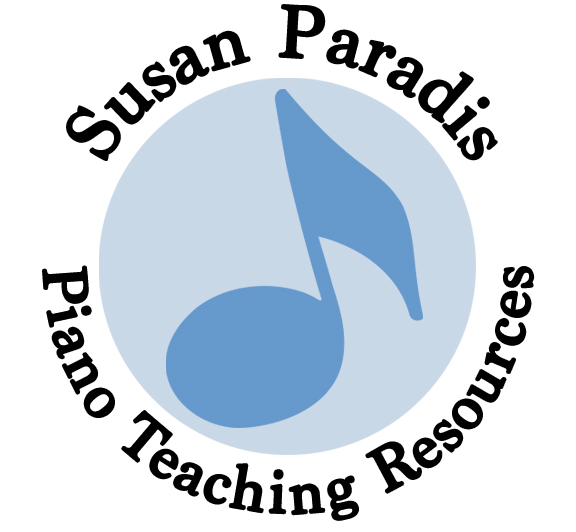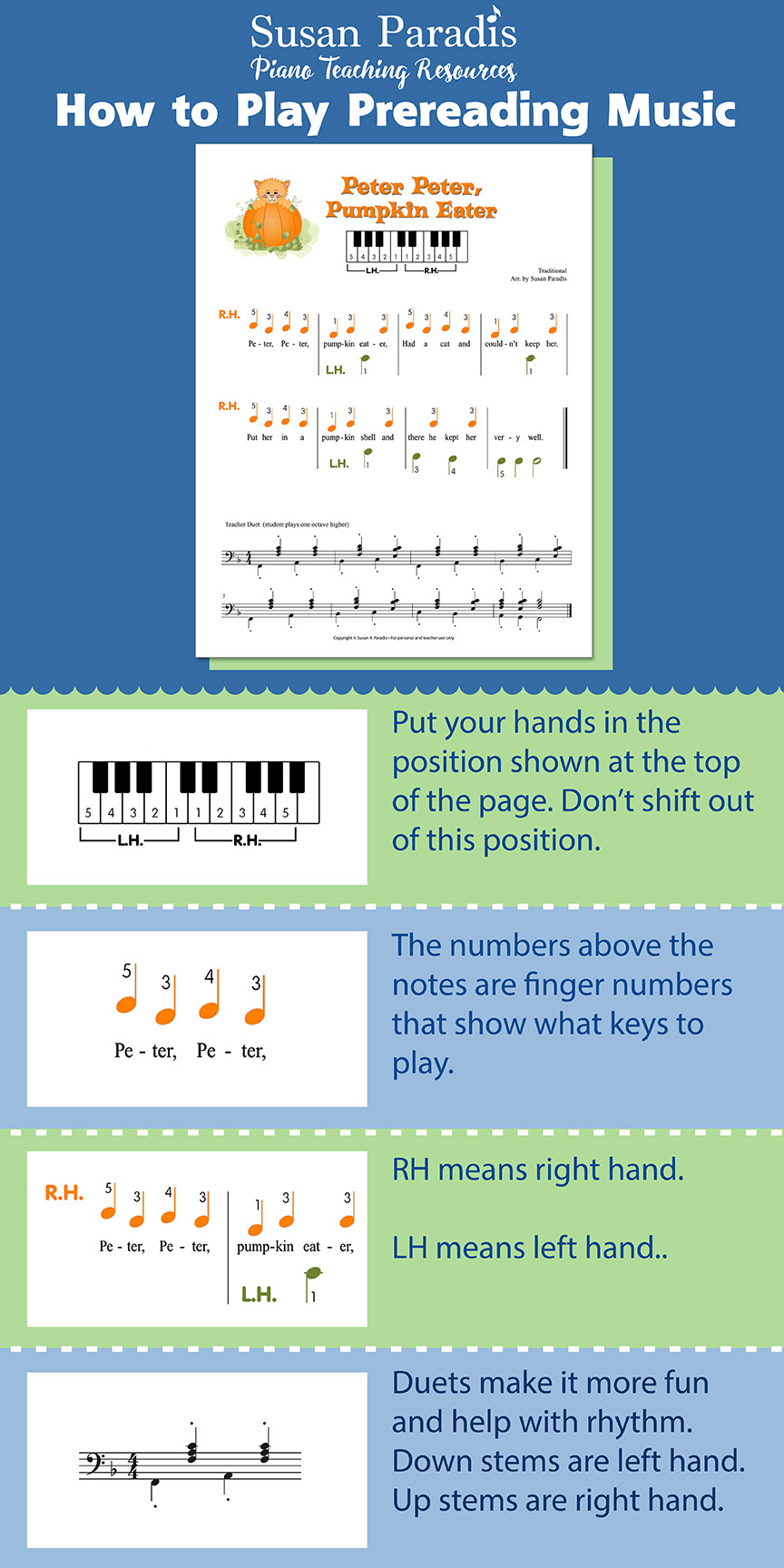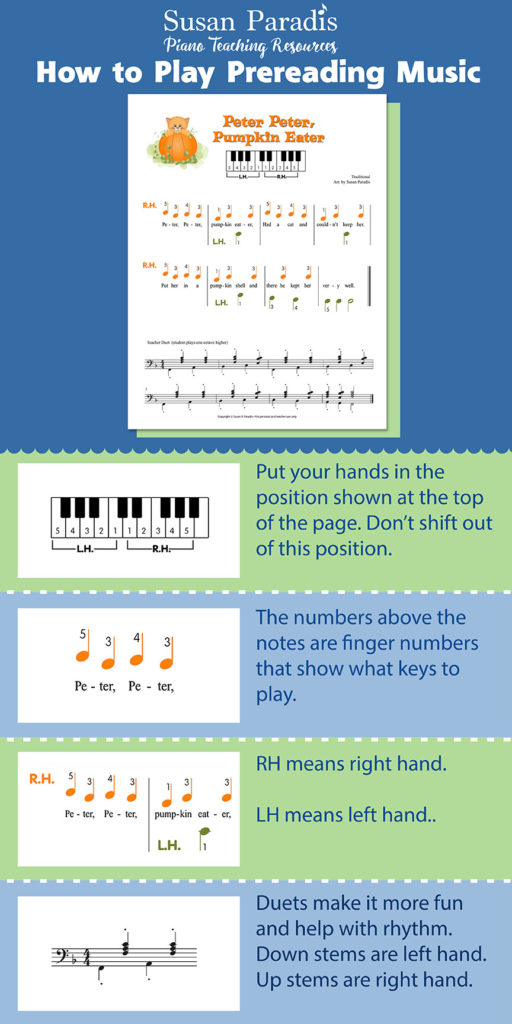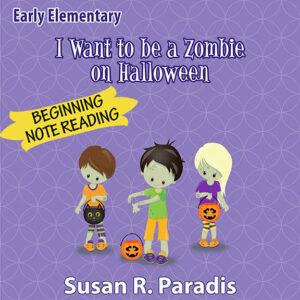How to Teach Pre-Reading Music
Pre-reading music for the piano is a simplified way to write music notes without a staff to complicate the process. Students can learn the concepts of up and down, finger numbers, rhythm, and hand placements in pre-reading music. Learning to read notes can be very challenging. Pre-reading music gives students an opportunity to become familiar with the process of playing the piano before the introduction of learning note names. It also is a more immediate way for students to enjoy their first lessons.
Many students start piano lessons in September, and can’t read music well enough to play regular Autumn and Halloween music. Many parents see pre-reading songs in their children’s new method books and want to be involved with lessons, but don’t know how.
This tutorial will explain what pre-reading is and how to use my Fall and Halloween music with your children. If you are a new teacher unfamiliar with pre-reading music, it might help you, too.
Example of Pre-reading Music
How to Teach Pre-reading Piano Music
First, do your homework before you start to teach it. Practice saying the song lyrics in rhythm by following the words. Play it yourself and if you play the piano, learn the duet part.
Next, teach the words to the student in rhythm, like a poem or nursery rhyme. Young children have a hard time reading in rhythm (if they can read at all) so teach the words by rote. They memorize quickly at this age. Keep a steady beat, pausing on the (clear) half and whole notes. That is how they will learn the correct rhythm.
When students can say the poem in rhythm, it’s time to tap the words on the piano cover, being careful to keep a steady beat. Start with just one sentence at a time, with the adult saying and tapping the words and the student repeating by rote.
I know every child wants to start playing right away, but if you want good rhythm, you start with rhythm!
When they can do that, students simply put their hands in the position that is shown on the little piano graphic at the top page. LH means left hand and RH means right hand.
On the piano, the right and left hand thumbs are number one. The pinkies are five.
Once their hands are in the correct position, students play the finger numbers listed above the notes. They keep their hands in the same position, except for the occasional movement, which will be labeled clearly. The last note above is an example of that. (Play on finger tips, not with straight fingers.)
Children need to play slowly. We would like them to play with a steady beat but at this point they might not be able to at first. Gently review the rhythm by saying and tapping.
What if the child can’t tap the words on the piano cover? Should you go on to the piano and try the notes? My opinion is that it will be fruitless to try to play notes if they can’t tap a simple rhythm by rote. But there are so many things they can do. Sing, dance, clap, march, listen. Start with simple things and progress. I started my children with two blocks that they could clap together after me. We can never stress early rhythm and musical experiences enough! If they are older and can’t tap rhythms, you will need to do a lot of remedial work.
Piano teachers have varying opinions about pre-reading music. Most teachers now realize that playing pre-reading music is very helpful. It helps students develop a steady beat and good hand position before the difficult skill of learning notes. I helps to orient them to the piano without the confusion of “what note is this.” I also think it helps with learning to read notes later on, and develops the ear.
Some teachers don’t like pre-reading music.
Some teachers think pre-reading is a hindrance, especially teachers who start with average and later-age beginners. They firmly believe students should just get it on with note reading and think that pre-reading can be a crutch.
I believe it really depends on the age and the ability of the student. Some of us have lots of preschool students and special learners. Others start gifted children, teens and adults who might not need it. Many teachers have their own method and it works. All of my free pre-reading music is also available on the staff. There is room for everyone in the piano teaching community!







Hi Susan.
you know I LOVE your music!
my concern is that I put both THUMBS (1st finger) on middle C. your music has a different hand position. Any thought of changing? Thank you. Enjoy the summer….. Teresa Reid
Teresa,
Thank you for your feedback, as I always appreciate that. I am going to try to explain why I use more than one hand position.
Both thumbs on middle C is an awkward hand position, and as a composer, you lose a note which really hampers the melody. It is so much more musical to be able to use the A above middle C or the E below middle C.
Once I gave up on exclusively using middle C position years ago, I noticed how much easier it was for my students to be better music readers. It might be a little slower at first, but it pays big dividends in the long run.
I do write some music in middle C position. Students need to learn how that feels. Open C position, where both left and right hand is in the C 5-finger scale is very helpful.
In my opinion, I strongly feel that getting their hands used to more than one way to play is very important. It also fosters self motivation. But I always include a piano graphic in my beginning music to help students find where to put their hands.
Many teachers have told me how helpful having several positions in my beginning books has been for their students. If it is the first time students have seen more than middle C position, some extra finger numbers are helpful until they get used to it.
That being said, positions are everything, so if what you do is working well, then great! I’ll put adding more middle C position music on my list of things to add to my site!
Susan
Thank you so much for the pre-reading Halloween pieces you offer on your site! I have used them for several years and love to see the reaction of seven year old student who is thrilled to learn a song for their favorite holiday. It’s nice to be able to offer them something that isn’t in their method book.
Kirsti,
Thank you so much! Your comment really means a lot to me!